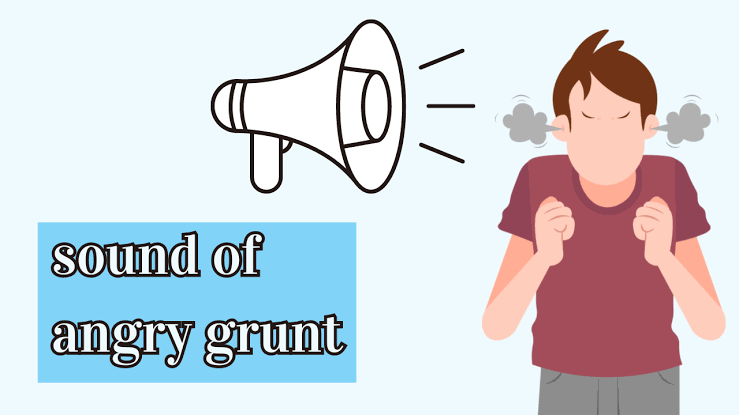Introduction to sound of an angry grunt
Angry grunts are a fascinating vocal expression that transcends species boundaries, manifesting in both humans and animals. These sounds, characterized by their guttural and forceful nature, serve as a powerful means of conveying anger or displeasure. In humans, angry grunts often emerge during moments of intense frustration or rage, providing an audible indicator of one’s emotional state. Similarly, in the animal kingdom, these grunts play a crucial role in communication, signaling aggression, dominance, or territoriality.
The universality of angry grunts underscores the primal nature of this vocalization. It is a sound deeply rooted in our evolutionary history, serving as one of the most basic forms of non-verbal communication. The raw, unfiltered quality of an angry grunt cuts through the complexities of language, delivering a straightforward message that can be understood across species. This shared vocal expression of anger highlights the interconnectedness of life, illustrating how fundamental emotions are communicated through sound.
Exploring the physiological aspects of angry grunts reveals how they are produced and perceived. These grunts typically emanate from the lower throat, involving the contraction of specific muscles and the expulsion of air. The resulting sound is often low-pitched and guttural, designed to capture attention and convey a sense of urgency. Psychologically, producing an angry grunt can provide a release for pent-up emotions, offering a form of catharsis in moments of high stress or confrontation.
Socially, angry grunts play a significant role in interactions within species. They can serve as warnings, deterrents, or expressions of dominance, influencing the behavior of others. Understanding the dynamics of these vocalizations can shed light on the complex social structures and communication strategies employed by various species, including humans.
The Physiology Behind Angry Grunts

The production of an angry grunt is a complex process involving several biological mechanisms. At the core of this process are the vocal cords, also known as vocal folds, which are located within the larynx. When a person is agitated or angry, the tension in the vocal cords increases, leading to a tighter and more forceful closure. This increased tension, combined with the forceful expulsion of air from the lungs, results in the characteristic harsh and guttural sound of an angry grunt.
The respiratory system plays a pivotal role in generating the necessary airflow. During an episode of anger, the body’s sympathetic nervous system is activated, leading to an increased respiratory rate. This heightened breathing rate ensures a greater volume of air is available to be pushed through the vocal cords, contributing to the intensity and volume of the grunt. Additionally, the diaphragm and intercostal muscles contract more forcefully, aiding in the rapid expulsion of air.
Muscle contractions, particularly in the chest and throat, also significantly influence the production of angry grunts. The constriction of these muscles not only helps to project the sound but also alters its pitch. Typically, an angry grunt is lower in pitch due to the tightening of the vocal cords and the increased pressure from the chest muscles. The duration of the sound is influenced by the length of time the breath is held and released, often resulting in a short, abrupt noise.
Changes in pitch, volume, and duration are critical characteristics that distinguish an angry grunt from other vocalizations. A higher volume and lower pitch generally indicate a higher level of anger or frustration. The duration can vary, but it is usually brief, mirroring the sudden burst of emotion. These physiological changes are not exclusive to humans; similar mechanisms can be observed in many animals, highlighting the evolutionary continuity in communication methods.
Psychological Triggers of Angry Grunts

Understanding the psychological triggers behind an angry grunt requires delving into the complex interplay of emotions and mental states that provoke such vocalizations. At the core of these triggers are emotions like frustration, aggression, and stress, which can manifest through distinct vocal expressions. An angry grunt, whether in humans or animals, serves as a non-verbal cue indicating heightened emotional arousal.
Frustration often arises from unmet expectations or obstacles impeding one’s goals. This emotional state can lead to vocalizations as a way of releasing pent-up energy or conveying dissatisfaction. For instance, a person might grunt in frustration when dealing with a challenging task or an unexpected delay, signaling their internal turmoil and need for relief.
Aggression, on the other hand, is a more intense emotional response that can trigger angry grunts. This often occurs in situations perceived as threatening or when an individual feels the need to assert dominance. In both humans and animals, an angry grunt in the context of aggression can serve as a warning or an attempt to intimidate others, thereby establishing social hierarchies or defending territory.
Stress is another significant factor that contributes to the production of angry grunts. Chronic stress can lead to heightened irritability and a lower threshold for anger, making individuals more prone to vocal outbursts. The physiological response to stress—marked by the release of cortisol and adrenaline—can amplify emotional reactions, including the propensity to grunt in anger.
The amygdala, a key region of the brain involved in processing emotions, plays a crucial role in the expression of anger. When the amygdala detects a perceived threat, it activates the body’s fight-or-flight response, resulting in increased arousal and the potential for vocal expressions like angry grunts. Other brain regions, such as the prefrontal cortex, contribute to regulating these emotional responses, although their influence may be diminished under intense emotional states.
In summary, the psychological triggers of an angry grunt are deeply rooted in our emotional and mental states. Frustration, aggression, and stress are primary catalysts, with the amygdala and associated brain regions orchestrating the resultant vocal expressions. These grunts serve as critical communicative tools, reflecting the intricate dynamics of human and animal emotional landscapes.
Angry Grunts in Human Social Interactions

Angry grunts serve as a non-verbal form of communication in human interactions, often conveying a range of emotions such as displeasure, frustration, or the need to assert dominance. These guttural sounds, though seemingly primitive, play a crucial role in social dynamics and can be a powerful indicator of one’s emotional state. In many instances, an angry grunt is an instinctive reaction, occurring when verbal articulation might be insufficient or unnecessary to express one’s feelings.
In social interactions, angry grunts can signal a boundary that has been crossed, serving as an immediate auditory cue for others to recognize and respond to. For example, in a heated discussion, an individual might emit an angry grunt to express their dissatisfaction with the direction of the conversation. This non-verbal cue can prompt a shift in the dialogue, signaling to others that a line has been crossed or that a particular topic is off-limits. The effectiveness of this form of communication lies in its ability to convey strong emotions succinctly, often preventing further escalation of conflict through a quick, recognizable sound.
Cultural variations also influence the expression and interpretation of angry grunts. In some cultures, these sounds may be more socially acceptable and understood as a normal part of emotional expression. Conversely, in other cultural contexts, an angry grunt might be considered rude or inappropriate, leading to different social reactions. The cultural norms surrounding non-verbal communication, including the use of grunts, are shaped by societal values and the collective understanding of acceptable behavior.
The social context in which angry grunts occur further defines their impact and meaning. In professional settings, for instance, an angry grunt might be interpreted differently than in a casual, familial environment. The relationship between the individuals involved and the specific circumstances of the interaction play a significant role in how these sounds are perceived and responded to.
Animal Kingdom: Angry Grunts Across Species
The animal kingdom presents a fascinating array of vocalizations that serve as a means of communication, particularly when expressing anger or aggression. Among primates, angry grunts are a common vocalization. For instance, chimpanzees often emit short, sharp grunts when they feel threatened or are engaged in a territorial dispute. These sounds serve not only to warn rivals but also to rally group members, highlighting the social function of these vocal expressions.
In the realm of canines, dogs exhibit a variety of vocal signals, including growls and grunts, to convey their displeasure or aggression. A dog’s angry grunt is typically deeper and more prolonged than its usual vocalizations, serving as a clear indicator of its emotional state. This form of communication is crucial for maintaining social order within packs and can also serve as a warning to potential threats.
Other animals, such as wild boars, produce distinct grunting sounds when agitated or threatened. These vocalizations are part of a broader suite of aggressive behaviors, including physical posturing and direct confrontation. The angry grunts of wild boars, much like those of primates and canines, play a significant role in social interactions and conflict resolution within their species.
The evolutionary significance of these vocal expressions is profound. Angry grunts and similar sounds likely evolved as adaptive responses to environmental pressures, facilitating survival through effective communication. In many species, these vocalizations serve to establish dominance, protect resources, and ensure the safety of the group. The ability to communicate anger effectively can deter potential aggressors and reduce the likelihood of physical altercations, thus conserving energy and minimizing injury risks.
Comparing these animal vocalizations to human expressions of anger reveals both similarities and differences. While the fundamental purpose of signaling emotional states remains consistent, the complexity and context of these vocalizations can vary significantly. Understanding these nuances enhances our comprehension of communication across species, offering deeper insights into the evolutionary roots of our own vocal expressions of anger.
The Impact of Angry Grunts on Relationships
Angry grunts, though often perceived as primitive expressions of emotion, play a significant role in human and animal communication. Their impact on interpersonal relationships can be profound, influencing both the dynamics and the outcomes of interactions. Frequent angry grunts can be indicative of underlying tension and unresolved conflicts, often leading to strained relationships. When individuals frequently resort to angry grunts, it may signal a breakdown in more nuanced forms of communication, such as verbal expression and active listening. This can create a cycle of misunderstanding and frustration, exacerbating existing issues and hindering effective conflict resolution.
However, it is important to recognize that angry grunts are not inherently negative. In many cases, they serve as a natural and necessary part of conflict resolution. Expressing anger through grunts can provide an immediate outlet for pent-up emotions, preventing the escalation of more destructive behaviors. In animal communication, for example, angry grunts often function as a warning signal, allowing individuals to assert dominance or establish boundaries without resorting to physical aggression. Similarly, in human interactions, angry grunts can signal the need for attention and intervention, prompting a more mindful and empathetic response from others.
To manage and interpret angry grunts effectively in relationships, it is crucial to develop strategies for both expression and reception. For those prone to expressing anger through grunts, incorporating mindfulness techniques and stress-reducing activities can help mitigate the frequency and intensity of these outbursts. Practicing open and honest communication, where emotions are articulated clearly, can also reduce the reliance on non-verbal expressions like grunts. Meanwhile, listeners can benefit from active listening skills, seeking to understand the underlying emotions and triggers behind the angry grunts rather than reacting defensively.
In essence, while angry grunts can pose challenges to relationships, they also offer opportunities for deeper understanding and connection. By recognizing the dual nature of these expressions and adopting proactive strategies, individuals can navigate the complexities of anger in a more constructive and empathetic manner.
Technological Analysis of Angry Grunts
The technological analysis of angry grunts involves a variety of sophisticated tools and methodologies designed to capture, interpret, and understand these distress signals. One of the primary tools used in this domain is acoustic analysis software. This software allows researchers to meticulously examine the sound waves produced during grunts, enabling the identification of specific acoustic features such as pitch, frequency, and duration. These features are crucial for distinguishing between different types of grunts and understanding their underlying emotional states.
In recent years, machine learning algorithms have significantly advanced the field of sound analysis. By training these algorithms on extensive datasets of recorded grunts from both humans and animals, researchers can develop models that accurately classify and interpret these sounds. The application of machine learning not only streamlines the analysis process but also enhances the precision of the findings. For instance, these algorithms can detect subtle variations in the acoustic signals that may be indiscernible to the human ear, thus providing deeper insights into the nuances of angry grunts.
Another pivotal technology in this area is spectrographic analysis, which visually represents the spectrum of frequencies in a sound signal. This method helps researchers visualize the complex structure of grunts, revealing patterns that correlate with specific emotional states or situational contexts. By comparing spectrograms of angry grunts across different species, scientists can draw parallels and identify commonalities in communication strategies.
Several case studies exemplify the efficacy of these technologies. For example, a recent study utilized a combination of acoustic analysis software and machine learning to analyze the grunts of primates in their natural habitat. The findings demonstrated that certain acoustic patterns were consistently associated with aggressive behaviors, providing valuable insights into the social dynamics of these animals. Similarly, research on human subjects has shown that angry grunts exhibit distinct acoustic markers that can be used to assess emotional intensity and potential for conflict.
Overall, the integration of advanced technological tools into the study of angry grunts has revolutionized our understanding of these vocal expressions. By leveraging acoustic analysis, machine learning, and spectrographic techniques, researchers can decode the complex language of grunts, shedding light on the intricate interplay between emotion and communication in both humans and animals.
Conclusion: The Significance of Understanding Angry Grunts
In the realm of both human and animal communication, the sound of an angry grunt stands as a potent indicator of emotional states. Our exploration has highlighted several dimensions—physiological, psychological, social, and technological—each contributing to a nuanced understanding of these vocalizations. By decoding the physiological mechanisms, we gain insight into the inherent, reflexive nature of these sounds, often rooted in stress responses or defensive postures.
From a psychological perspective, angry grunts are not merely expressions of frustration or aggression. They serve as audible signals that can influence the behavior of others, potentially defusing conflicts or establishing social hierarchies. This is particularly evident in both primate studies and human social interactions, where such vocal cues play a crucial role in group dynamics and individual relationships.
Socially, the ability to interpret these vocalizations accurately can significantly enhance interpersonal communication. Understanding the underlying emotional states leading to an angry grunt can foster empathy and improve conflict resolution strategies. This is especially important in multicultural settings where misinterpretations can lead to escalated tensions.
Technologically, advancements in acoustic analysis and artificial intelligence provide new frontiers for understanding and responding to these vocal signals. Applications range from improved human-computer interactions to enhanced animal welfare practices. For instance, AI systems capable of recognizing and appropriately responding to angry vocalizations could revolutionize customer service or provide timely interventions in mental health settings.
Future research should focus on cross-species comparisons to further elucidate the evolutionary origins of these sounds. Additionally, integrating multidisciplinary approaches could lead to more comprehensive models of vocal communication. The practical applications of this understanding are vast, promising improvements in areas ranging from conflict resolution to technological innovations.
In essence, the study of angry grunts transcends mere curiosity, offering profound implications for improving human and animal interactions alike. By continuing to explore this intriguing facet of communication, we pave the way for enhancing our understanding and fostering more harmonious relationships.


